





The following article is a basic step-by-step introduction to staging succulent plants, either for show, sale or personal enjoyment.
Staging is pretty much what it sounds like: putting your plant on stage, or display. Basically when you stage a succulent, you are getting it ready to show it off. This means repotting it in a nice pot that emphasizes the plant, not the pot, and there usually are some bonsai qualities to these displays (but not always). The following are some basic steps to follow for staging a plant for the first few times. Then as you become more experienced, you can get very creative and try for something unique. But this article will at least cover most of the basics to help get you started.
Step 1: Choose a plant. The best plants to choose for staging for a show, sale or for your own collection, when you are just learning, are those that are fairly easily staged and will look good soon. Some succulent plants need to be grown in their containers for some time before the roots spread and securely keep the plant solidly in its new pot. Those plants may be excellent staging plants, but need too much time for purposes of these demonstrations. A pot with good, gnarled and succulent roots work the best, or a healthy grown smaller cactus will do well, too. Succulents with small roots, or that are top-heavy, such as large Agaves, Aloes or the larger columnar cacti need much longer adjustment times, but can still make excellent staging plants. However it might be best to avoid these at first.
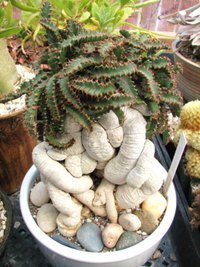
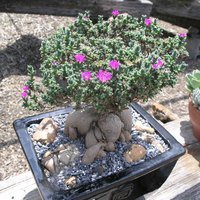
Neither one of these are my plants, but these are two of the easiest and hardiest plants to start with (Euphorbia stellata, left, and Trichodiadema bulbosum, right). Both have large, gnarled succulent root systems and are very hard to kill
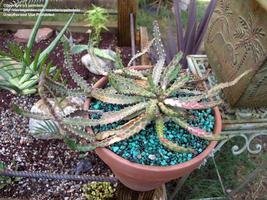
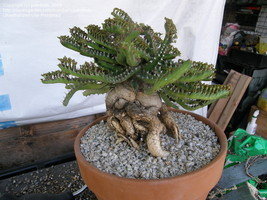

three shots of my Euphorbia stellata when I first potted it up (ignore the weird top dressing); my first 'raising of the roots' (again, wrong top dressing); and my most recent repotting of this plant, over a period of 4 years.
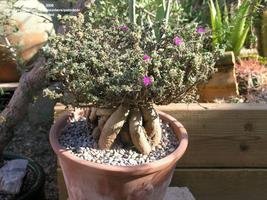
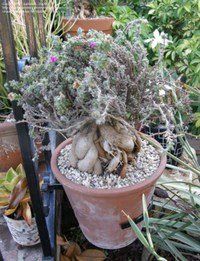
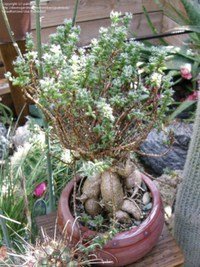
My Trichodiadema bulbosum after it was first raised 3 years ago, and again this year (middle). Photo on right shows another plant that has been in the same dinky pot for 5 years... so you don't need to move them up if you don't want to
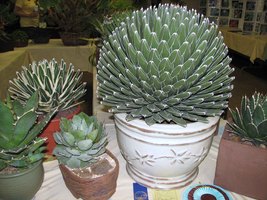
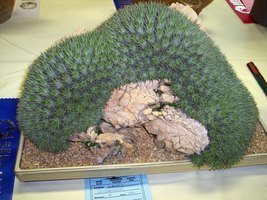
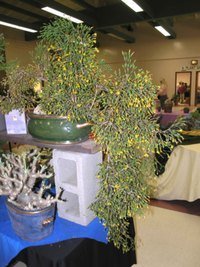
Some examples of staged plants that are better for more advanced gardeners: Agaves (left) need to root for a whole, Deutercohnia takes a LOT of patience and experience (middle) and this Hatioria is very tricky to stage without falling out of the pot (right)
Step 2: Choose the pot. Most of the time, a low, flattish pot that is somewhat attractive, but not brightly colored or too exciting is a good choice; it will not outcompete the plant for attention. The reason for low, flat pots is they symbolize the bonsai look which most find appealing. The lower the pot, the more the plant dominates the display, while the pot serves more as the plants ornamental landscape. Sometimes, depending the shape of the plant, tall, thinner pots will work well. Try to avoid cheap-looking or plastic pots. See this article for more on succulent pots.
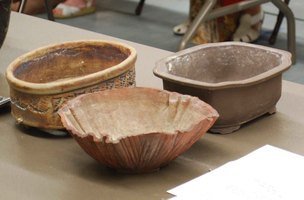
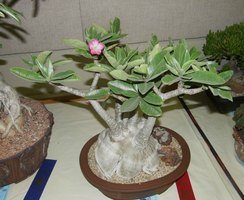
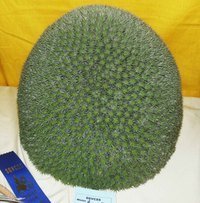
Some excellent pots to start with; note they are all flat, low and bonsai-like. (left); This Adenium swazicum has a huge rooted caudex in an incredibly low pot, a very good and popular look (middle); I am not even sure if this Deuterocohnia is in a pot; I never had the guts to lift it up and peek (right).
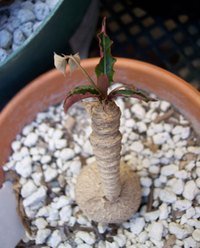
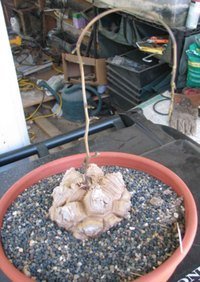

This is my own Adenia on the left in a pot that probably would get kicked out of a show--do as I say, not as I do!; The next two photos show grossly overpotted plants in cheap-looking pots.
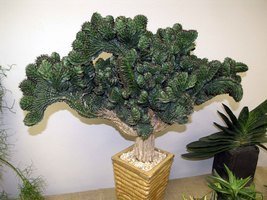
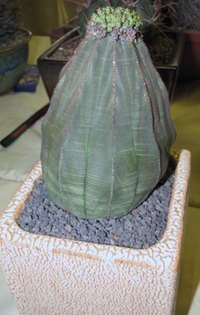
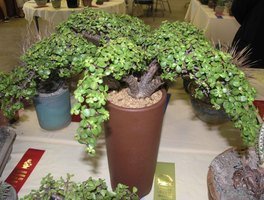
Sometimes a tall pot can work if the subject plant is the right shape. The Euphorbia on the left overpowers its tall pot and works well. The Euphobia obesa in the middle, tall pot is somewhat overpowered visually by the pot, and this does NOT make a good stage. The Portulacaria afra on the right is well grown and though the pot is unusually tall, it works
Step 3: Choose the soil. There are probably a limitless number of soil recipes that work for potting and staging succulents and cacti. However, since most will work fairly well, there really are only a few ‘rules' to follow for greater success, and the rest is up to the individual. Drainage is key. One should use a soil mix that drains immediately, with the water running out the bottom of the pot nearly as fast as it gets poured in the top. Anything slower than that and you risk rot, fungal problems and salt accumulation difficulties. The simplest recipes recommended by the experts I defer to involve using a favorite potted soil in a bag and mixing it about 50/50 with pumice. That's it. Most potting soils will work well, but try to avoid those with a lot of peat in them, as peat compacts over time, and is hard to re-wet once it dries out, making it more likely the plant could desiccate. The reason for the pumice is simply drainage, air retention (there should always be sufficient air in soil) and anchorage--pumice is a heavy by airy substance that will help keep the soil in place without making it compact. Perlite can be substituted for pumice but is not nearly as choice as it is too light and harder to keep in the pot. Also perlite is riskier to work with at it usually has a light, silica dust that is not healthy to inhale and it can irritate your eyes.
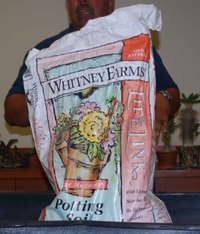
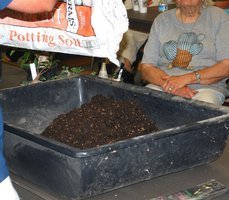
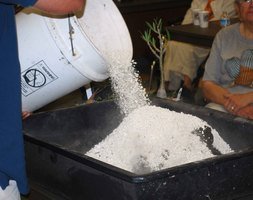
The demonstration on staging I recently witnessed during a Cactus/Succulent club meeting in the San Fernando Valley, California, this was the soil of choice of those particular growers, but they both insisted one could pick just about any potting soil and have excellent results; In middle photo, soil is put in a mixing pot that is low and easy to use- do NOT dump old soil in this pot! (right) a bag of pumice is added to a nearly 50:50 mix
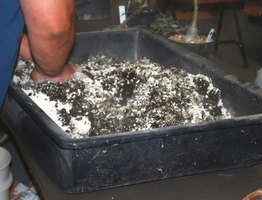
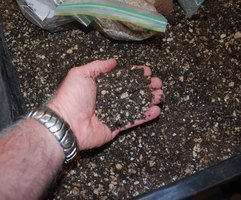
Mix the soil well... you should have a mix with enough pumice to look like the soil in the photo on the right
Mix the soil well, and it's best to use it fresh out of the bag if possible. Soil that sits around for weeks will work, but it's usually dried out at that point and will be harder to wet in the near future. Also dry soil does not compact down as well, and subsequent waterings may end up causing the soil level to sink in the pot necessitating repotting in the near future.
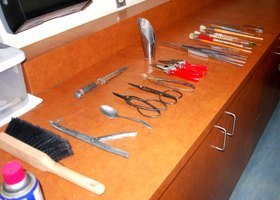
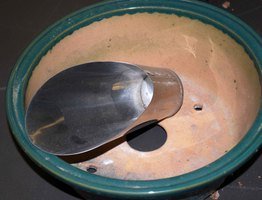
I should mention that the proper tools can make the whole job of staging that much easier. Just some of the tools that one will need include brushes for tamping and cleaning the base of the plant (or getting soil out of the spines), bonsai scissors and nippers for trimming the branches, spoons and top-dressing spreaders (tool in second photo) for applying the gravel into all the nooks and crannies without getting rocks all over your plant, WD-40 for cleaning off the pots (gets old salts off well when one is reusing a pot) etc.
Step 4: Ready the plant. Dump the plant out of its old pot and get it ready to put in the new pot. That means getting rid of most, if not all the soil on the current roots, as well as removing mealy bugs, weeds, dead or rotting roots and trimming off excessive roots and branches. When removing the soil, do not mix the discarded soil in with the new soil. Pretend that old soil is contaminated and use it elsewhere (in the garden, with compost etc.). Some growers will actually hose the existing roots clean removing every speck of old soil before repotting. This is not normally necessary.
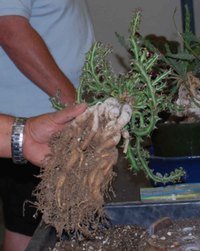
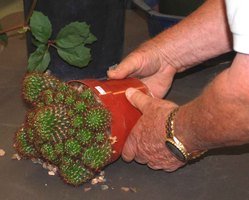
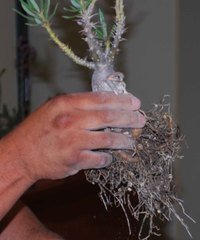
The three plants above will be the primary ones used in the following demonstrations (a 4th will be seen below). Euphorbia sp. on the left, a Parodia in the middle, and Pachypodium succulentum on right
Trimming is best done before repotting as you can often disturb the newly repotted plant by excessive trimming making it shift in its new home, necessitating repotting yet again. Do NOT be wimpy with the pruning! The biggest mistake made (and the one I continue to personally make over and over) is not being aggressive enough about pruning roots and branches. The will grow back! And the more roots pruned and removed, the more room for new, interesting roots to grow, and more room to cram rocks in between the old roots improving the ornamental look of the plant.
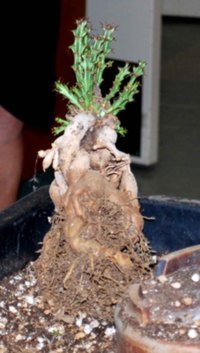

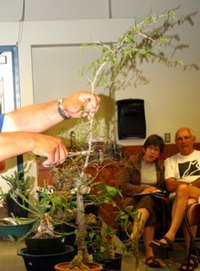
The plant on right is the same plant seen in the first photo just above it. Note how aggressive the demonstrator was in removing greenery. This is one of the most difficult steps to get people to do, but it's simple- just bold. The 'prize' part of the plant in this case are its root, not the green branches, so those need to be cut way back- not to worry- they will rapidly grow back. In the middle photo, the demonstrator felt the root was too big and uninteresting, so he just broke it in half... another scary thing for most inexperienced growers to do. The photo on the right shows the demonstrator hacking off nearly half this bonsai tree
If dealing with cacti, the same rules apply though there is rarely much reason for pruning, other than to remove suckers that don't match or are damaged/rotting. Cactus roots are relatively wimpy compared to most other succulent roots but that does not mean one should be too dainty when removing soil or opening up their root balls. Cactus roots grow back.
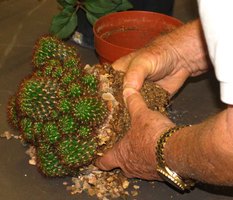
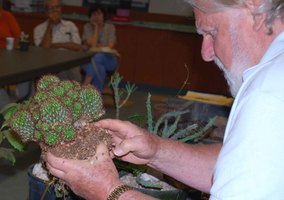 removing the soil and a lot of roots, too
removing the soil and a lot of roots, too
When staging plants for show, it is a rule of thumb to put one plant per pot. Suckering plants are fine, but separate plants, unless they look like they are suckering, should be avoided (will usually be disqualified, if showing these displays). Never mix species for show, unless there is a mixed species category (this does not occur too often, though I think that's too bad). Mixing species for sale can make a really attractive display. For more on community pots, see this article.
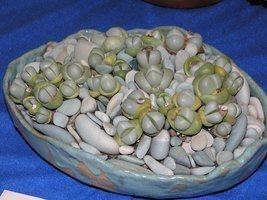
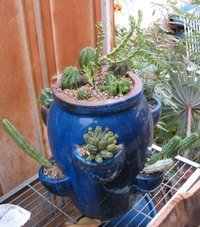
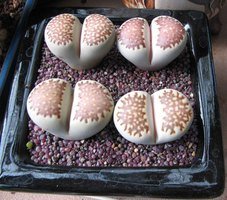
The first and third photos are nice arrangements of mesmembs, but would not qualify in many show as there are multiple plants in each display. The middle photo is one of my Euphorbia pots... looks great today, but has many species in it, so would not qualify in a show
Step 5: Prepare the pot and add some soil. By preparing the pot, really all that is meant is to put some sort of screen or mesh over the drainage holes to keep the soil from falling out of the pot. I often forget this step, which is not a vital one if using a large or deep pot. But shallow bonsai pots often have fairly large holes, and soil can easily escape out the bottom leaving a pot nearly devoid of soil (and plants will desiccate). These screens also keep the roots from coming out the bottom. You can buy black bonsai screen, or use some other mesh substance (regular screen, needlepoint sheets etc.) as long as it's not too fine to let water through with little impedence. Only add enough soil to basically cover the bottom of the pot and hold the cut screen(s) that will cover the hole.
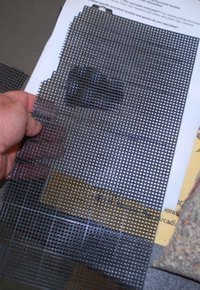
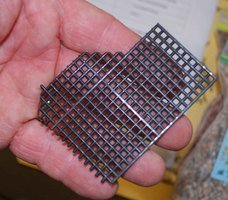 Bonsai screen, and cut to size to cover a pot hole
Bonsai screen, and cut to size to cover a pot hole
Step 6: Put the plant in the new pot. Most of the time, you will want to ‘raise up' the plant from how it was grown in the previous pot, to show off more root structure for ornamental value. This is NOT necessarily how these plants grow in nature and most will grow with their roots completely if not mostly submerged. This is a key difference between staging a plant, and growing it up for garden use or showing in the future. Since staging pots are generally bonsai pots, one is sort of forced to replant the pot raised up anyway. This creates a problem of stability sometimes, but rarely a problem of survival as many might think once they see the repotted plant with so much root exposed, not under the soil where it's supposed to be. With few exceptions, succulents plants with succulent roots tolerate this fairly well. Those without succulent roots need to be planted back in such a way as to bury all their roots (most cacti, aloes, agaves, crassulas etc.). However these non-succulent-rooted plants still fit fairly easily in the bonsai pots simply because their roots are smaller, softer and less extensive. They just may be more difficult to stabilize and may, in some cases, require more time to adjust afterwards before they can be moved or transported for show or sale.
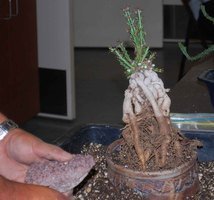
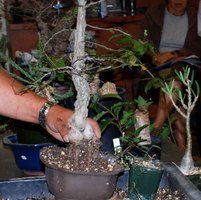
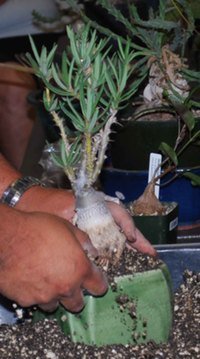
All the above plants have been set into their new pots, already with some soil in them, the amount depending on how much the stager wants the plant to sit above the edge of the pot. Note that the cactus stager is using welding gloves for this part. In none of these plants is a true 'front' a real issue as these plants are all fairly small and simple and the pots are either circular, or evenly square.
As you are putting the plant back in the pot, you should decide which is the ‘front' of the plant. A bonsai concept is that all plants have a front and the front should be positioned accordingly, particularly if you are not using a circular pot. Circular pots make the front less of an issue as the plant can be turned later to show the front. But angular pots cannot be turned so easily without either seeming off balance or not fitting on the shelf easily. Most rectangular pots will be shown with their broad sides facing the viewer, so one must position the plant keeping that in mind. Some plants do not have an obvious front, and sometimes inexperienced growers cannot decide or tell what the best side of the plant is (this is a problem I often have, too). Experience going to shows and repotting plants will help with this ‘artistic' step.
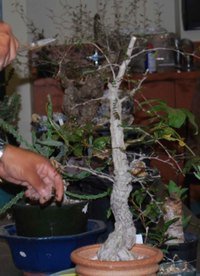

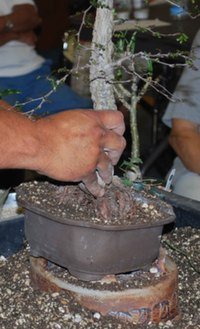
This small bonsai tree (Operculicarya decaryi) is going from a circular pot to a rectangular one, so some effort is being made by the stager to put its 'best face' forward.
Then you must stabilize the plant. This is done by gently compressing the new soil with either your fingers or with a brush or tool made for this procedure, holding the roots in place. Also, this is where rocks come in to play. Adding rocks to a staged pot is truly an art and I am certainly no expert here. Rocks not only add a wonderful ‘natural' landscape look (making the plant look as if it's growing out among the rocks as it might in nature) but help immensely to stabilize the plant by compressing the soil further and simply supporting the plant from falling over. Choosing a rock is a skill that takes practice. In general, avoid super smooth or geometrically symmetrical rocks (not very ‘natural'). Also you need to select a rock based on its color, trying to find some harmony with the pot color and/or subsequent top dressing color. Brightly colored, smooth, pink quartz would probably be a poor choice in most cases, despite it being a beautiful mineral. Generally, rough, dark, muted tones work best. Shapes should be flattish and angular allowing them to easily support themselves on the soil surface, or allowing the stager to fit them between the roots. Sometimes ‘breaking' these ‘rules' works well, so don't be afraid to experiment... but one will notice most winning show displays rarely include bizarre or unusual rock shapes or colors.
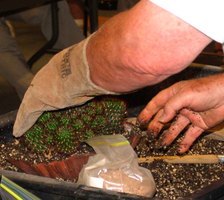
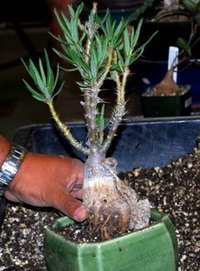
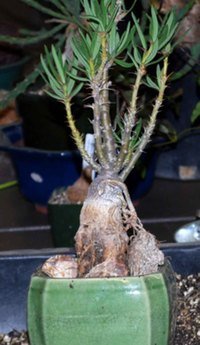
This smaller cactus is fairly easy to stabilize as it is not very top-heavy... but it's spiny, so, again, thick gloves are recommened; The Pachypodium succulentum in the next two photos has been raised up quite a bit to show off it's interesting, succulent roots, so it has to be stabilized with some rocks.
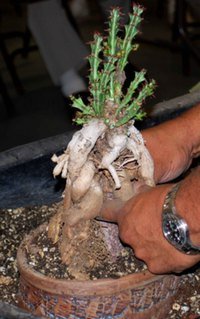
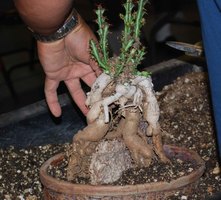
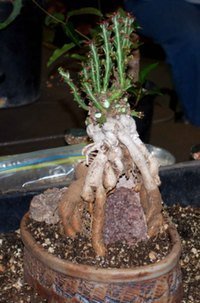
Stablizing the Euphorbia while simultaneously spreading out is roots to make them more interesting
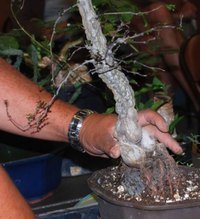
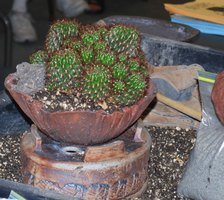
a large rock is also being used to spread and stabilize the bonsai tree on the left; a rock has been set in with the cactus, too, but more of an afterthought and for looks than anything really practical
Once the plant is in the pot and positioned properly, soil should be gently tamped down further or removed so that it is about a centimeter or so below the edge of the pot. A paint brush works well for this procedure. The soil should be pushed the deepest right along the edges of the pot, making a more secure ‘ditch' for the top dressing to fill.
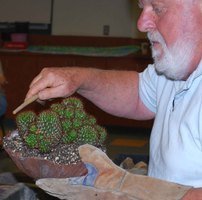
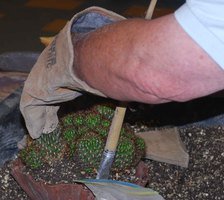
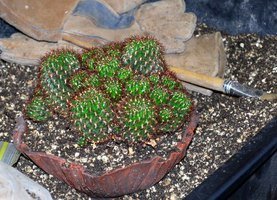
Here the cactus is being tamped down, and the soil tamped down, both with paint brushes (mostly to avoid spines); third photo on right show plant ready for top dressing
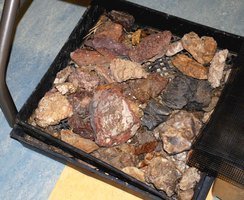
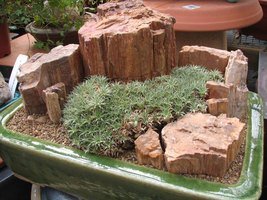
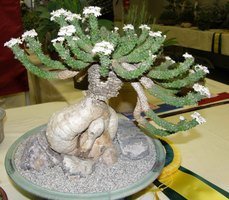
having a nice collection of staging rocks is a real plus and one learns to start looking out for and collecting these rocks for future projects. Sometimes its the shape and positioning of the rocks that really makes the whole stage a beautiful creation.
Step 7: Add the top dressing. This is also an ‘artful' step but a fairly easy one that can take a fairly nice looking staged plant and give it the finishing touches to make it truly a beautiful display. Again there are some rules, which I typically ignore, but shouldn't. Generally, avoid smooth top dressing as this looks less natural (according to most judges). Sadly, smooth rocks are much more commonly available and much cheaper so I tend to use them a lot for my plants I keep. Rough, gravely top dressings of small, but not sand-small diameter are by far the most popular and are generally what most choose to display with their plants. Brilliantly colored top dressings are also frowned upon (like the kind one finds in an aquarium shop). Some top dressings are very small (like garnet sand or large silica sand) which make a nice surface for display. However these smaller sized dressings are too easily washed off or disturbed when watering so most avoid except for right before a show or sale. Very large diameter stones usually make too rough a surface but work OK with larger pots or as a contrast to a particularly smooth, large plant.
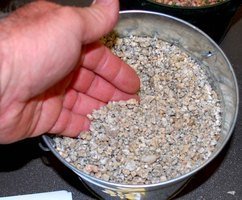
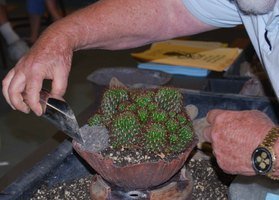
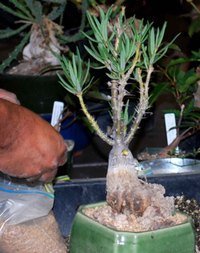
simple gravel can make a great top dressing. Also picking the right color of dressing, keeping in mind both the color of the pot as well as the plant is important.
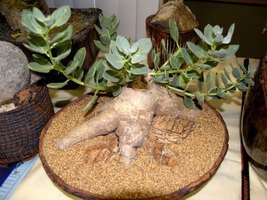
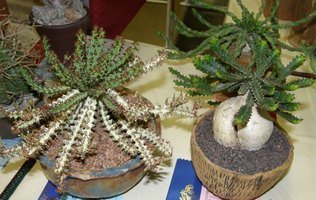
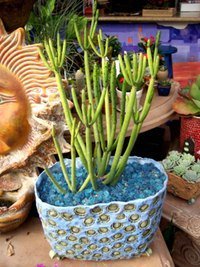
different colors of top dressing accentuate different parts of the whole picture. Whimsical designs such as in the third photo are great for selling plants, but would not do well in a show (judges are far too conservative for the most part)
Top dressings not only have an ornamental value, but they are essential in keeping the soil in the pot while watering, and keeping the soil humidity up so the soil doesn't dry out too quickly. Soils that are completely dry tend to repel water making the potted plant much more difficult to water adequately. This is why top dressings should really be applied to just about any potted plant, whether for display, show or simply to keep around the house or yard. Top dressings also can add a protective barrier between the plants lower leaves and branches, keeping them from sitting on or in the soil. Soil contact breeds all sorts of complications from rot to bug infestation. Top dressing dries almost instantly keeping the incidence of rot down, and making the contact point less inviting to bugs.
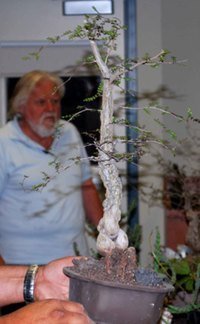 Finished plant with top dressing, rocks and trimmed
Finished plant with top dressing, rocks and trimmed
Step 8: Watering. Many growers will not water a newly staged plant, particularly if a lot of heavy root pruning was done (recently cut roots are more prone to rot), but realistically, as long as the climate is warm and relatively dry, and the soil is an excellent draining one, this is not usually a problem. So watering can be done 2 to 4 times a week or as needed per each species of plant. Under-watering newly staged plants can sometimes be a problem as the thinner layer of soils dry out too quickly sometimes. If there has been one thing I learned from trying to grow non-succulent bonsai, is that one cannot forget to water. Succulent plants are obviously more resistant to desiccation, but that does not mean they don't benefit from regular, consistent watering. I find that well-staged plants can usually be safely watered daily as long as it's warm and dry out.
Step 9: Fertilizing. This is probably the least important step along the way, and many growers I have talked to hardly ever fertilize. Most good potting soils have plenty of micronutrients, and many succulents grow in soils very low in nutrients as well. One can ‘push' a plant to grow faster, larger and greener with fertilizer, but these plants may be weaker and less ornamental in the long run. This is why many growers of potted succulents and cacti grow their plants ‘hard' (no excessive watering, shade or fertilization). ‘Hard' plants are slower growing but tend to stay more compact and seem to last much longer in a pot without having to be pruned all the time, or moved up to another pot size soon. And these plants of course need less care by definition.
Step 10: Enjoy your plant!
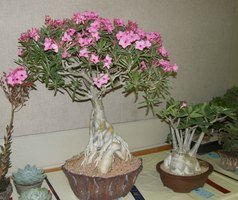
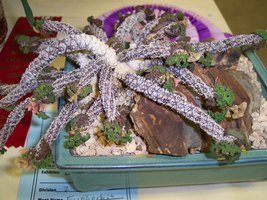
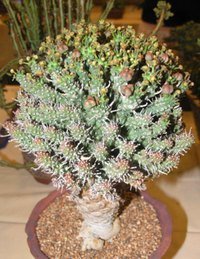
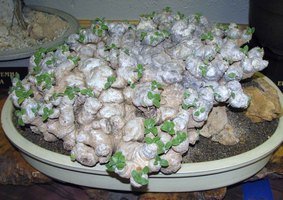
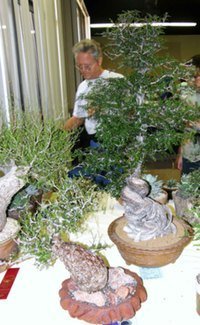
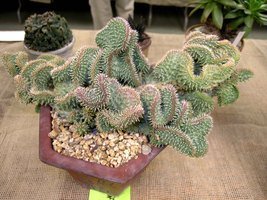
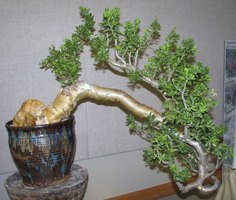
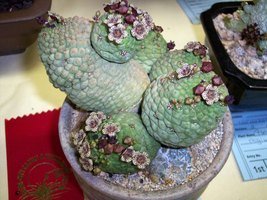
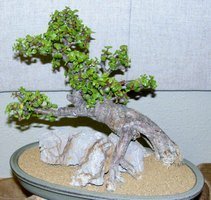
Just some examples of well staged plants I have seen in various shows over the last few years.
Copyright © www.100flowers.win Botanic Garden All Rights Reserved